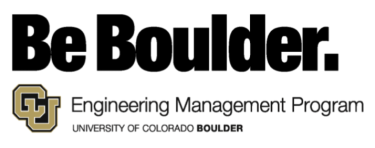Why is Product Liability Important for Engineers?

It’s a topic often overlooked by individuals pursuing a career in engineering. It’s an area that’s not typically covered in undergraduate or graduate-level engineering programs. We’re talking about product liability and the very real and significant role it plays in the lives of professional engineers every day.
“We as engineers do our best to design products that function in the way we want them to function,” says Michael Readey, Professor of Engineering Practice at CU Boulder’s Lockheed Martin Engineering Management Program (EMP). “But as much as we don’t want to have to think about it, products can fail. Typically, they fail as a result of some defect in manufacturing or really bad design. But failures do happen and they can have major consequences.”
What is Liability?
Product failure is what usually brings engineers into the complex world of product liability, the area of law focused on determining who is responsible when failures occur and cause injuries or even death.
You don’t have to look far to find real-world examples of design, engineering, or manufacturing failures that have quickly become the center of international news. Recently, the National Traffic Highway Safety Administration estimated that more than 41 million vehicles equipped with 56 million airbags were affected by a faulty propellant canister, which resulted in the airbags exploding and hurling shrapnel at passengers. This prompted one of the largest airbag recalls in history and the failure is currently in the midst of litigation.
Even more recently, Boeing’s 737 Max 8 jetliner was grounded when, within a space of five months, two crashes killed nearly 350 passengers. The cause of the crashes has been attributed to a newly-designed automated Maneuvering Characteristics Augmentation System that caused planes to make virtually uncontrollable maneuvers unexpectedly. The impact of that failure has been felt across the globe and it continues to have enormous implications for the families involved, the aircraft manufacturer Boeing, its leadership and the entire airline industry.
Not all product liability law cases are as massive in scale and notoriety as these well-known examples. But that doesn’t make them any less significant in the everyday lives of engineers. Product liability can include examples such as injuries caused by footwear with insufficient traction, faulty machinery, tools that don’t perform as required, defective recreational products and playground equipment, and in one case, firearms that were proven to have a faulty fire control system.
“When we’re talking about product liability, the focus is on what kind of legal exposure there is to a company when these kinds of failures happen,” Readey says. “In many situations, this ultimately moves on to include litigation that can involve engineers who may be called to testify based on their involvement with that particular product or as an expert witness.”
Why is Product Liability Important for Engineers?
Given the very direct impact that product liability law can have on the lives and careers of engineers and technical professionals, one would think it would be an area of emphasis in bachelors and masters level engineering programs. In most cases, however, this hasn’t been the case.
A little more than a year ago, CU Boulder took a new approach after a university benefactor with a distinguished career as an aeronautical engineer, and then later as an attorney, approached them with an innovative idea—create a course to bring engineering students from the EMP together with students from the University’s Law School for a dynamic, comprehensive training experience focused on product liability and the litigation process.
“The idea was to structure a course that blended the engineering and legal issues related to product liability,” Readey says. “It was a very interesting idea. Engineering students are involved in product development issues but we never talk about what happens if the product doesn’t perform the way it’s supposed to. And when you think about it, engineers are usually the first people who are called in when a product failure occurs to provide answers, insights and expertise.”
EMEN 5830-003: Engineering, Product Liability & the Litigation Process
This idea spurred the development of a new course for the Engineering Management Program. The course, EMEN 5830-003: Engineering, Product Liability & the Litigation Process, brings together EMP students and law students to understand the legal ramifications of catastrophic product failure. The course offers engineering students a realistic experience of working through a product failure and subsequent product liability lawsuit, from the very beginning of the failure analysis investigation to a mock trial where engineers are “on the stand” being interrogated by their legal counterparts.
Now in its first year, the course is taught by Readey in tandem with a law professor who has extensive experience as a litigation attorney. It provides an ideal introduction to product liability for engineers who are interested in the legal process, who may be considering careers within the legal profession, or who simply want to be prepared for a time when they may be called upon to represent their company or their client.
“In the course, we go through a real-world issue of product liability. We explore who was at fault, the extent of the problem, what other problems it may have led to and what would be the best way to resolve it,” Readey says.
“The law students write out a complaint working closely with the engineers who act as expert witnesses,” Readey explains. “There’s a deposition of expert witnesses—law students conduct the deposition asking the engineers a series of questions, and all of the law students and engineers in the class go through this process. It’s an eye-opening exercise that introduces all of them to the kind of gravity these situations hold. It’s one thing as an engineer to really know your stuff, but what our students find out is that it’s a different game when you’re on that hot seat with all these questions coming at you.”
An Interactive, Dynamic Experience
One of the key benefits of the course is that class size is kept relatively small to allow each student to have the most engaging, dynamic and interactive experience possible whether they are engineering or law students.
“To date, it has been an exciting and fun exercise, exposing the engineering students to what the responsibility of an engineer is in these circumstances, whether they are involved in the product’s development or are involved as an expert witness,” Readey says. “And then we have the law students who get a feel for how and why products can fail; they gain familiarity with engineering terminology, how to work with expert witnesses, how to depose in cases like this, and write and read reports.”
Readey says that for the engineers, it shines a light on a legal process they may not have considered before. “They work closely with the law students and gain a clearer picture of what legal professionals do and how they may work together at some point down the road.”
Relevant, Current Instruction From Seasoned Industry Leaders
The EMP course also includes guest lectures from a variety of professionals who have working experience related to product liability. These guest lecturers have included Mark Sirangelo, former President of Sierra Nevada; Richard Schaden, CEO of Schaden Law; and John Wojick, former Vice President at Boeing.
During Wojick’s visit to the course, students benefited from his insights into the current product liability issues surrounding the failures of the company’s 737 Max 8 aircraft. Although Wojick wasn’t employed at Boeing at the time of the failures, he addressed students from a technical perspective, as well as discussed how the company approached the situation from a public relations and messaging standpoint.
“Right there, our students were getting valuable insights presented by someone with extensive professional experience about a product liability issue that is happening right now, and is one of the most significant of these types of cases we’ve seen in some time,” Readey says.
Providing a Lifetime of Value to Future Engineers and Lawyers
While the product liability course is still a new offering, Readey says he has already seen the impact it has had on his students.
“I think the real value of the course is that students look beyond the academic side of engineering,” he says. “This opens their eyes to the fact that good engineers and good companies don’t always get it right. It also opens their eyes to the fact that, as an engineer, you don’t get to control everything. Again, one of the reasons products fail is because of defects that occur during manufacturing. That’s something that is out of your control but obviously has a very direct impact on the product that you’ve been involved with designing. Students need to understand that failure can and does happen.”
Another benefit EMP students gain from the course is exposure to new types of professional opportunities that they may have not considered, such as serving as an expert witness, which can also provide a substantial amount of supplementary income. “Engineers and technical professionals have, in fact, made careers out of providing their insights and professional knowledge as expert witnesses,” Readey says.
Clearly, to effectively serve as an expert witness takes more than extensive knowledge of the industry and product that’s at issue during liability litigation. It also requires a deep understanding of the legal processes involved. “Our knowledge of litigation is pretty limited, usually to what we see on TV,” Readey says. “But there’s a lot that goes on behind the scenes and students in this course now have a more solid understanding of what those processes are.”
A Personal Professional Perspective
Readey has a direct, personal connection to the world of product liability. As an engineer, he had been working on a pollution control system when a problem arose which brought the product out of compliance with the standards set forth by the Environmental Protection Agency (EPA).
Readey was called upon to provide his insights and perspectives as a way to find answers for correcting the system. He worked with an array of attorneys to ensure that the failure was addressed and that the system would remain EPA compliant.
“One of the popular impressions of product liability lawsuits is that they’re all frivolous—people going after money, lawyers as ambulance chasers and all that,” he says. “But I was reminded by a colleague once that it does actually lead to good things. It forces companies to evaluate and re-evaluate the products they’re putting out there, which moves technology ahead and leads to positive change.”
EMP at CU Boulder: A Spirit of Innovative Programming
The newly launched product liability course is not the only example of CU Boulder’s legacy of developing innovative, relevant courses and engineering management offerings based on the needs of industry and the engineering profession.
One offering that’s closely related to the product liability course is Business Law for Engineering Managers, which covers a range of legal aspects that are valuable for engineers to understand, such as copyright law, intellectual property and patents.
Other innovative courses developed recently include Intrapreneurship and Innovation, Global Topics in Aerospace, and Principles and Practices of the Sustainable Enterprise, a course Readey teaches exploring ways to integrate sustainability into technology-based businesses and startups. The course, which is practical and hands-on, teaches students the tools and skills to develop and market products that meet the needs of today’s growing number of eco- and socially-conscious consumers.
If you would like to learn more about the product liability course or any of CU Boulder’s EMP offerings, please visit the website to request more information. You can also email Kendra.Thibeault@colorado.edu or call 303.492.0954.



